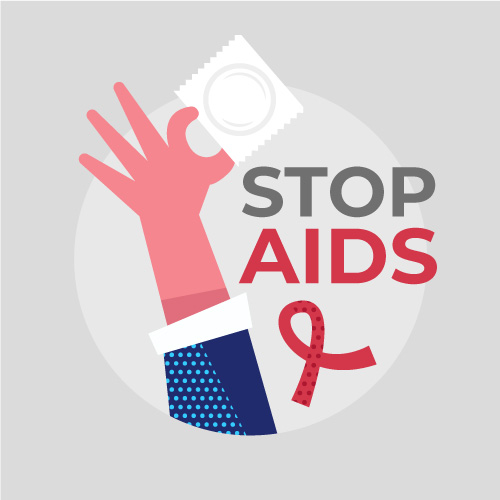- [email protected]
- Mon - Sat: 08.00 am - 05:00
- Creating awareness and mobilising resources to end AIDS in India

Phone 202 303 405
Notice: Test mode is enabled. While in test mode no live donations are processed.
Despite advances in information systems, research and clinical practice, HIV/AIDS is a threat to the youth of today. In fact, as per UNAIDS estimates, 35% of all new infections occur in the 15-49 years age group, and 37% of reported AIDS cases were diagnosed among people under 30 years of age. Young people need the tools to protect themselves from HIV infection and we know a lot about what works.
However, youth are quite often misinformed or reckless and often not able to comprehend fully the extent of their exposure to the virus. Societal norms make it even more difficult for young ones to learn about their sexual health. Peer pressures easily influence them – often in ways that increase their risk.
So how can one safeguard against HIV/AIDS today? Click here to download the Youth Handbook to Safe & Responsible Sex.

Most of us are aware that a condom is a must during intercourse to prevent against HIV/AIDS, various other sexually transmitted diseases and unwanted pregnancies. However, the condom has been at the center of controversy and gossip and the information below will hopefully clear the air and put the record straight.
Plenty of people think that using two condoms is safer. Utter nonsense! In fact, this is a bad idea. The friction of one condom rubbing against another could cause both to rupture, leaving you completely defenseless. Latex condoms in particular are not designed to rub against one another. Save yourself the trouble and the money and stick to one at a time.
Some people also believe that condoms are ineffectual which is completely untrue. When properly used, a condom can greatly reduce the risk of HIV transmission. The important thing is that you know how to use a condom properly and that you use a new condom every time that you have sex. In fact, in terms of contraception, condoms are 97 percent effective in ‘perfect use’ and 86 percent effective with typical use. Perfect use is not hard to accomplish; it consists mainly of just putting on the condom correctly. The most important thing that you can do is to use a new condom every single time that you have sex.
There is a notion that condoms have holes that HIV can pass through. This is not at all true as long as you use a latex or polyurethane condom. Semen and vaginal fluids, which can contain HIV, cannot get through a latex or polyurethane condom. In fact viruses that are smaller than HIV cannot pass through condoms either. When condoms are manufactured (on a mould) they are dipped into the latex, dried, and then dipped in again to ensure that any pores large enough for a virus to pass through are sealed.
Men generally feel that condoms come in the way of pleasure. Today, thanks to Technology, condoms are tailor-made for sensual pleasure while providing maximum security. There are different types of condoms designed for you and your partner to indulge in.
The rumor mills have been doing the rounds on this one for quite a while. Condoms don’t have to be used when the female is on birth control. A distortion of facts. Birth control medication prevents pregnancy. That’s it! It can’t prevent the transmission of HIV or other sexually transmitted diseases.
| So, remember the truth about condoms and don’t let anyone tell you otherwise. |
Learn to use the condom correctly. Click to get your checklist.
L
| Youth and HIV/AIDS – Its Your (Sex) Life | |||||||
|
| Keep it simple and just give the facts about symptoms, treatment, how the disease is spread, and how you can protect each other. This is a difficult conversation that will likely stir up a lot of emotions, but try to think of this as simply sharing vital information. |
| Then give your partner some time and space to digest the news. After all, it probably took you a while when you first heard. Offer to provide more information or an STD hotline number. With time, most people take the news pretty well and don’t let it stand in the way of the relationship (and if they don’t take it well, it’s better to find out before the relationship goes too far.) With everything that’s been learned in recent years about STDs and their transmission, it’s entirely possible for people with an STD to have a satisfying sex life without passing infection to their partners. |
| Source (content & images) = It’s Your (Sex) Life Your Guide to Safe & Responsible Sex THE HENRY J. KAISER FAMILY FOUNDATION |
Heroes AIDS Project is a national HIV/AIDS initiative launched in July 2004 to work with media organizations and societal leaders in India. It seeks to develop coordinated campaigns to address the spread of HIV/AIDS and reduce stigma and discrimination by influencing public perception and policy through two platforms: advocacy and communications.
Heroes AIDS Project is a national HIV/AIDS initiative launched in July 2004 to work with media organizations and societal leaders in India. It seeks to develop coordinated campaigns to address the spread of HIV/AIDS and reduce stigma and discrimination by influencing public perception and policy through two platforms: advocacy and communications.